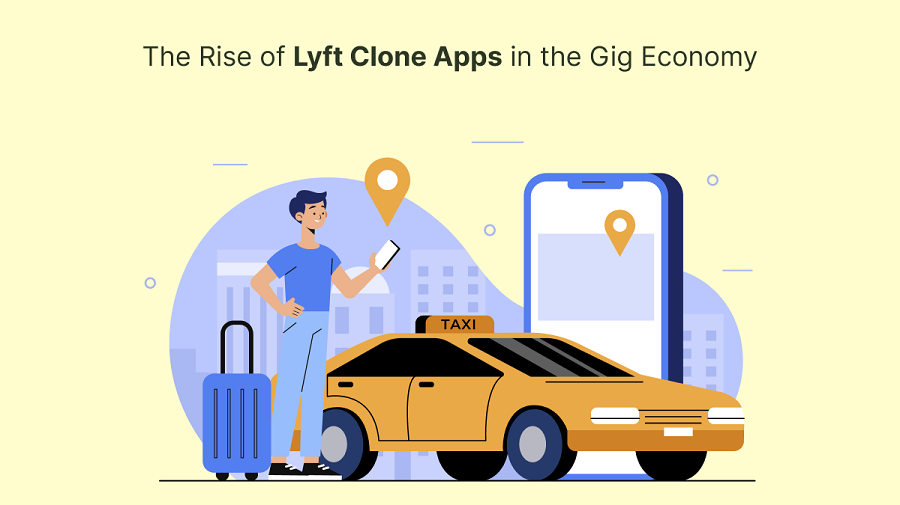The Rise of Lyft Clone Apps in the Gig Economy

The gig economy has fundamentally transformed how traditional industries function, merging workforce flexibility with instant service access to reshape modern work culture and consumer habits. Nowhere is this shift more visible than in ride-hailing, a sector revolutionized by giants like Uber and Lyft. But as the market grows crowded, a fresh opportunity is gaining momentum: Lyft-style clone apps.
The Gig Economy’s Role
—————————————
This shift is driven by two key groups:
- Workers seeking autonomy and flexible schedules.
- Consumers demand instant, affordable services.
Ride-hailing epitomizes this model. Platforms connect drivers (gig workers) with passengers (consumers), creating a symbiotic ecosystem. A Lyft clone app replicate this framework, offering businesses a plug-and-play solution to launch their own branded services. Unlike building software from scratch, these clones provide pre-built features like GPS tracking, fare calculators, and payment integrations, slashing development time and costs.
Why Lyft Clone Apps Are Disrupting the Market
—————————————
Lower Barriers to Entry
Clone apps eliminate this hurdle. For example, a startup can license a white-label solution for 15,000–50,000 and launch within weeks. This democratizes market access, enabling smaller players to compete with giants like Lyft.
Customization for Local Markets
Clone apps allow businesses to tailor platforms to regional needs:
- In Southeast Asia, integrating mobile wallets like GrabPay or GoPay.
- In Europe, adding multi-language support and compliance with GDPR.
- In emerging markets, cash payments are offered to cater to unbanked users.
Scalability and Diversification
Clone apps aren’t limited to ride-hailing. Entrepreneurs are expanding into bike rentals, food delivery, and even healthcare transport. For instance, a Lyft clone in Brazil, 99, successfully added delivery services during the pandemic, doubling its user base.
Opportunities for B2B Stakeholders
—————————————
SaaS Providers and Developers
Tech companies offering clone scripts are thriving. Platforms like Radix and Zippr generate recurring revenue by selling licenses, customization services, and maintenance packages. This B2B niche is projected to grow at 12% CAGR through 2027.
Franchise Models
Established businesses can license clone apps to regional partners. A logistics company in Germany, for example, might partner with local fleet owners to launch a ride-hailing service in Africa, sharing profits while mitigating operational risks.
Data-Driven Insights
Ride-hailing platforms generate goldmines of data—peak travel times, popular routes, and user demographics. B2B players can monetize this by:
- Selling analytics to urban planners for traffic management.
- Partnering with advertisers to target commuters.
- Optimizing driver allocation to reduce idle time.
Navigating Challenges
—————————————
While the potential is vast, businesses must address critical challenges:
Regulatory Battles
The gig economy faces global scrutiny over labor rights. In California, Proposition 22 reclassified gig workers as independent contractors, sparking legal debates. Clone app operators must:
- Stay updated on local labor laws.
- Invest in legal teams to handle disputes.
Building Trust
New platforms struggle to gain user confidence.
Solutions include:
- AI-Powered Safety Features: Real-time driver monitoring, SOS buttons, and ride-sharing insurance.
- Transparent Ratings: Public driver reviews and strict background checks.
Market Saturation
With low entry barriers, markets like Southeast Asia and Latin America are overcrowded. To stand out, businesses must:
- Focus on niche segments (e.g., luxury rides, pet-friendly vehicles).
- Offer loyalty programs or subscription models.
Case Studies: Lessons from the Frontlines
—————————————
Careem (Middle East)
Before Uber acquired Careem for $3.1 billion, it dominated the Middle East by adapting to local culture. It offered cash payments, Arabic-language support, and prayer-time notifications for drivers—a strategy clone app operators can emulate.
BlaBlaCar (Europe)
Starting as a ride-sharing platform, BlaBlaCar expanded into bus ticketing and corporate travel. Its success lies in using data to optimize routes and pricing, proving the value of diversification.
Ola (India)
Ola outpaced Uber in India by adding auto-rickshaw rides and accepting local payment methods like UPI. This highlights the importance of hyper-localization.
 Future Trends Shaping the Industry
Future Trends Shaping the Industry
—————————————
Autonomous Vehicles
While still nascent, this technology could reduce reliance on gig drivers, lowering operational costs for clone app operators.
Sustainability Initiatives
With ESG goals rising, platforms now incentivize EVs, fueling a shift to sustainable transport. For example, Lyft plans to go 100% electric by 2030—a trend clone apps can adopt to attract eco-conscious users.
Blockchain Integration
Blockchain can enhance transparency in payments and data security. Startups like Drive are already using decentralized models to give drivers more control over fares.
Strategic Recommendations for Businesses
—————————————
To capitalize on the Lyft clone app boom, B2B leaders should:
- Target Underserved Markets: Focus on regions with limited ride-hailing penetration, like rural areas or secondary cities.
- Invest in AI and Safety: Use machine learning to predict demand and enhance user safety.
- Adopt Hybrid Workforce Models: Combine gig drivers with part-time employees to improve service reliability.
- Collaborate with Governments: Work with policymakers to shape gig economy regulations.
Conclusion
Lyft clone apps are more than a tech trend—they mirror the evolving gig economy. These low-risk platforms open a gateway to the $130B mobility market. To succeed, companies must partner with an app development company to embrace agile innovation, localize offerings, ensure robust safety, and drive sustainability to lead. Embrace the change!!
As tech and transportation merge, one truth stands clear: the future of mobility rewards swift adapters. Lyft clone apps are more than optional—they offer a strategic edge. The challenge is not merely to adopt them but to outsmart competitors and redefine how we move. Innovate now to lead. Start up!




